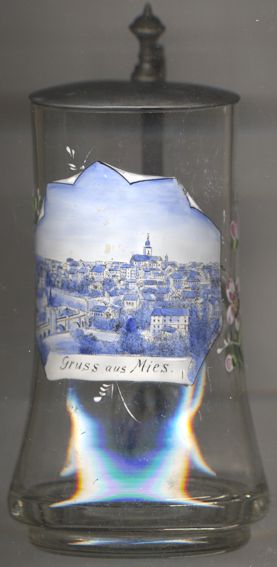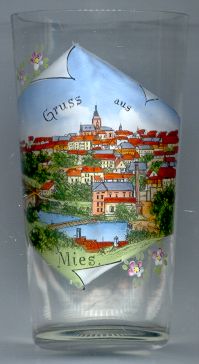

|
| ČESKÁ REPUBLIKA | CZECH REPUBLIC |
| Plzeňský kraj | Plzeň region |
| Okres: Tachov |

 Stříbro (German: Mies) is situated at an elevation of 444 m on the river Mže (Mies) about 30 km
west of Plzeň. The municipality has a population of about 8,000 (2023).
Stříbro (German: Mies) is situated at an elevation of 444 m on the river Mže (Mies) about 30 km
west of Plzeň. The municipality has a population of about 8,000 (2023).
Stříbro was first mentioned in a document of 1183. One factor contributing to the wealth of Stříbro as early as the 12th century was mining for silver, lead and tin, which became the origin of the Czech name of the town (stříbro = silver). Before the mid-13th century the early settlers left the original site in the basin of the valley and moved to a more elevated place on a rocky ridge. Stříbro soon became a prosperous town due to its favourable location on a trading route from Prague to Nuremberg. At the beginning of the 15th century Stříbro was the fourth-largest royal town in the Plzeň region of Bohemia. In 1427 knights returning from the 4th Crusade besieged the town but were defeated by the Taborites (see also Tábor) in the Battle of Tachov. The importance of the town declined when mining for silver ceased to be profitable during the 17th/18th century. The historical town centre of Stříbro boasts numerous houses from the Renaissance and Baroque periods and has been put under monumental protection.
Jakoubek ze Stříbra (Jakoubek of Stříbro, Jacobellus of Mies) (ca.1375–1429), one of the central characters of the mild wing of the Hussite movement, introduced the Holy Communion from the chalice as a symbol of Christian equality for all believers.
The  church of All Saints [background top] goes back to an original chapel that was replaced by a
late-Gothic church in 1565. Most parts of the church date from the reconstruction in Baroque style that was done in 1754–1757.
church of All Saints [background top] goes back to an original chapel that was replaced by a
late-Gothic church in 1565. Most parts of the church date from the reconstruction in Baroque style that was done in 1754–1757.
The  Stříbro bridge [far left, no. 4547: far left], a five-span stone bridge
spanning the river Mže, was built in the Renaissance period. The bridge has one preserved passage tower, built between 1555 and 1560.
Today the bridge is used for pedestrian traffic only. The structure is still preserved in its original form, except for the US Army inscriptions
added in 1945, which can be found above both tower portals. It was declared a Czech cultural monument in 1958 and has been part of the
Stříbro urban monument zone since 1992.
Stříbro bridge [far left, no. 4547: far left], a five-span stone bridge
spanning the river Mže, was built in the Renaissance period. The bridge has one preserved passage tower, built between 1555 and 1560.
Today the bridge is used for pedestrian traffic only. The structure is still preserved in its original form, except for the US Army inscriptions
added in 1945, which can be found above both tower portals. It was declared a Czech cultural monument in 1958 and has been part of the
Stříbro urban monument zone since 1992.
[https://de.wikipedia.org/wiki/St%C5%99%C3%ADbro, https://en.wikipedia.org/wiki/St%C5%99%C3%ADbro;
https://en.wikipedia.org/wiki/St%C5%99%C3%ADbro_bridge]
![[scale]](lineal.jpg)